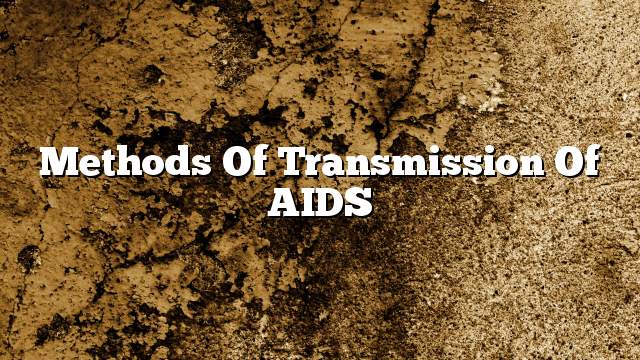HIV
Human immunodeficiency virus (HIV) and HIV are still a serious global health issue. HIV infection has killed 35 million people so far. In fact, HIV attacks the immune system (T-helper cell), also referred to as CD4 cells, which gradually destroys the patient’s immune system and makes him susceptible to many diseases. It is worth mentioning that the virus proliferate in the body Patient, and it takes its destruction to the organ Aa entirely about 10 to 15 years if the victim did not receive treatment.
AIDS
HIV / AIDS refers to Acquired Immunodeficiency Syndrome, the latest stage of HIV infection. It is a group of symptoms and health disorders caused by severe immune system weakness and loss of ability to cope with disease. If not received, The infected person will cause AIDS, and it usually takes two to 15 years to reach AIDS.
Ways of transmission of AIDS
In fact, HIV or AIDS is not transmitted by water, air, or insect bites, but its transmission requires the arrival of an infected fluid into the body, such as blood, semen, and vaginal secretions, so that the disease will not be transmitted by shaking, hugging, Communication that does not involve dealing with the fluids of the injured, and the ways in which the fluid travels to others, causing the transmission of infection to them as follows:
- Sexual communication: Whether it is oral, vaginal, or anal, where the infection is transmitted through oral ulcers or anal incisions.
- Blood transfusions: Transfusion of HIV-contaminated blood causes transmission of infection.
- Sharing injections: The involvement of the infected person injects the infection.
- Pregnancy and Birth: The virus may spread from the infected pregnant mother to the fetus during pregnancy or at birth.
Risk factors for AIDS
There are several factors that increase the risk of HIV infection, including:
- Sexually Transmitted Infections (STIs), which cause ulcers and lesions in the external genitalia, act as an HIV outlet and allow access to the body.
- The practice of unsafe sexual intercourse, ie without the use of condoms, which reduces the likelihood of transmission of sexually transmitted diseases.
- Anal sex.
- Have sex with more than one person.
- Share injections with other people when taking intravenous drugs.
- Non-circumcision of men.
Symptoms of HIV infection
The symptoms that appear on the patient depend on the stage of the infection in which they go through, and the symptoms can be divided depending on the stage of the disease, as follows.
Acute or primary symptoms
Symptoms begin to appear in a form similar to influenza symptoms after about a month or two of the entry of HIV into the body, and soon disappear after several weeks, and although the symptoms are simple and almost not noticeable at this stage, but the amount of virus in the blood will be Very high, and the symptoms and signs that appear at this stage include:
- Fever.
- Skin rash.
- Headaches.
- Pain in the muscles and joints.
- Inflammation of lymph nodes.
- Sore throat.
Chronic symptoms
Clinical latent infection is also known as the chronic stage of HIV (HIV), and lasts about 10 years if the patient does not take antiretroviral therapy, Stage to decades if the patient took antiretroviral drugs, it is worth mentioning that the patient does not suffer during this stage of any specific symptoms except the swelling of the lymph nodes in some, and remain the human immunodeficiency virus in the body and in white cells infected with all these Stage.
Advanced symptoms
Over time, HIV multiplies and continues to destroy the immune system. Symptoms and signs that a patient may suffer at this stage include:
Symptoms of AIDS
At this stage, the immune system is in a poor state, which increases the chance of opportunistic infections. Symptoms of opportunistic infections include:
AIDS complications
Because of the destruction of the immune system, HIV makes the person susceptible to many infections, cancers and diseases, including:
- Tuberculosis (TB).
- Cytomegalovirus.
- Candidiasis.
- Cryptococcal meningitis.
- Toxoplasmosis.
- Cryptosporidiosis.
- Kaposi’s sarcoma.
- Lymphomas.
- Wasting syndrome.
- Nervous complications; such as depression, anxiety, and confusion.
- Kidney disease.
